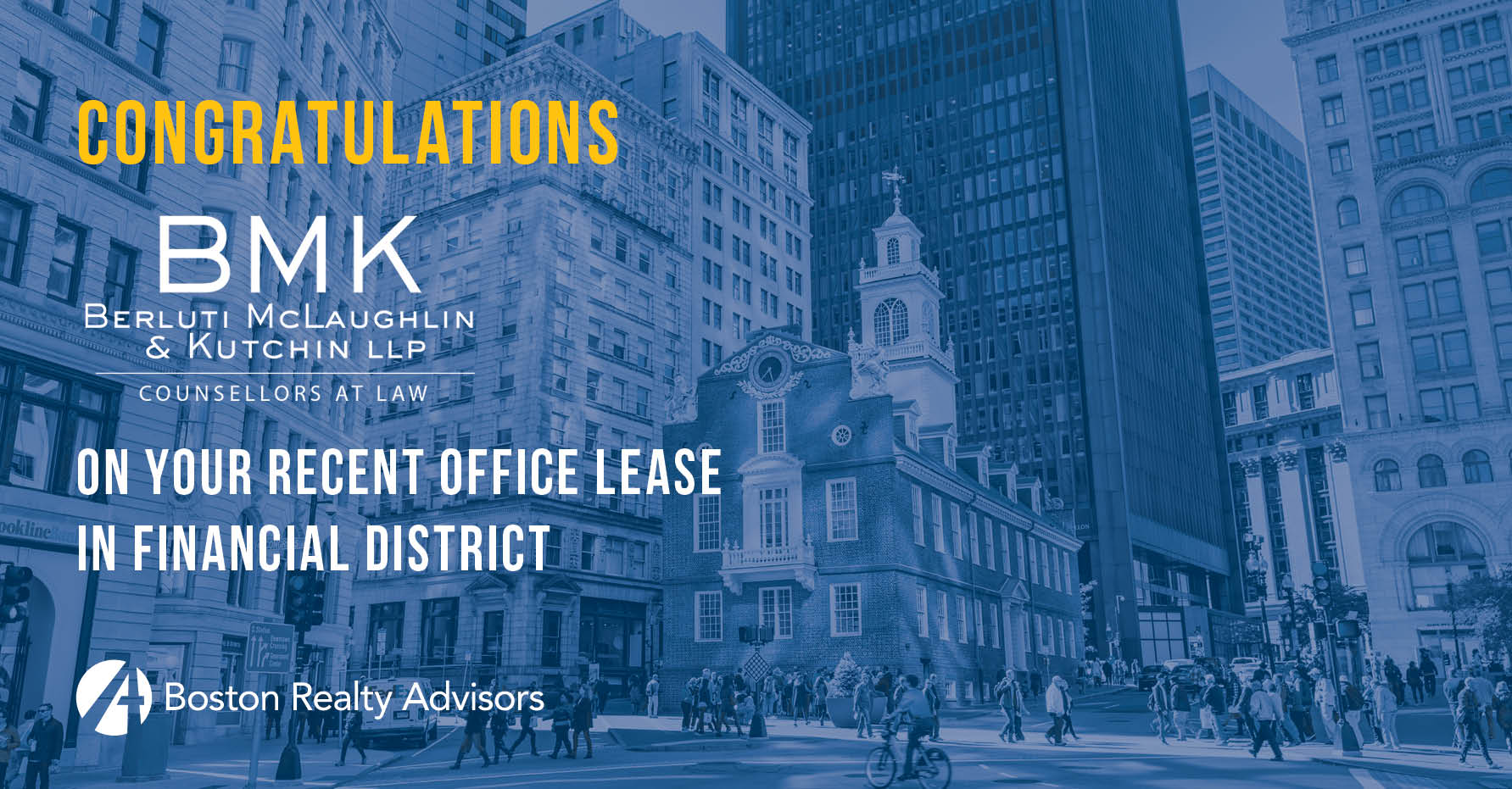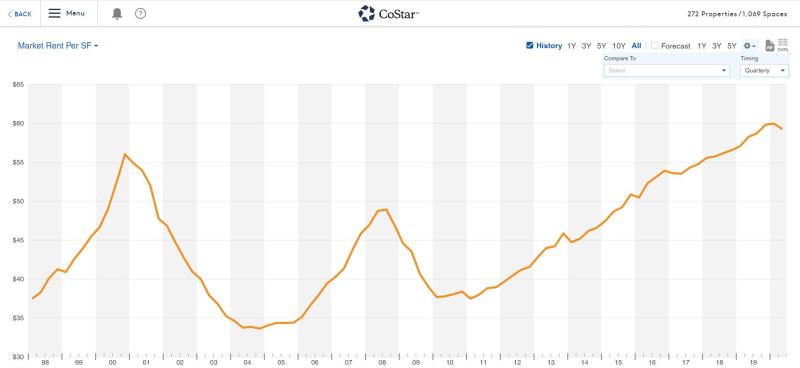
Category Archives: Financial District Boston Office Space
0 CRES Stats Report | Week Ending December 11
CRES Stats Report | Week Ending December 11
- 27 spaces hit the market as available in the subject area in the last 7 days, equating to 226,000 SF which is above the recent range;
- 21 spaces (over 1,000 SF) came off the market equating to 174,000 SF;
- The availability rate in Boston ticked up again slightly this week at 15,600,000 SF;
- The question now is when the availability rate will “top out”, with the effects of the COVID therapies versus leases ending (and those tenants renewing, downsizing, going virtual or relocating out of the downtown)?
0 The Future of Office Amidst Covid-19
Moderated by Wil Catlin (Boston Realty Advisors) with a star-studded panel, including Michael Maturo (RXR Realty); Matthew Friedman (Rockwood Capital); Arthur Jones (Principal Real Estate Investors); and Robert Deckey (Invesco US)
ABOUT THE VIRTUAL EVENT
iGlobal Forum Live introduces a brand-new virtual event, providing you with key insights into the Offices market.
This 1-hour discussion is the perfect opportunity to delve into this key commercial real estate sector with industry leaders, both from asset management and acquisition standpoints, enabling you to get solutions you can take back and use in real time.
Key topics include:
- Flex-space and Space-As-A-Service feel highly relevant, yet how can they survive new health requirements?
- Will tenants downsize and relocate to minimize costs? Or will they create grand offices that are branding exercises to draw people back together?
- What are asset management teams doing to protect portfolios in this C-19 environment?
- What solutions are available for elevators?
- How much will operating costs increase?
- How are sector benchmarks or metrics shifting to meet the new Covid-19 reality?
- In future, will an employer’s location matter less, and if so, what does that mean for the office sector?
Register HERE.
0 Boston launches $6M fund for business reopenings
Boston officials have pledged $6 million in grants to support small businesses where employees must work in close proximity with either coworkers or customers — such as hair salons and barber shops, retail stores, gyms and food service establishments — to provide personal protective equipment so those businesses can reopen.
Companies with fewer than 15 employees can apply for up to $2,000 for materials such as masks and safety partitions for customers and employees. The funding will be available in three rounds: first, for personal services including barber shops and hair salons; second, for retail, restaurants, nail salons, day spas, waxing and laser services; and third, for bars, arts and entertainment venues and fitness businesses.
Applications open Thursday at 5:00 p.m. at boston.gov/reopen-fund.
“When our small businesses are ready and able to open, we want our business owners and workers to have access to the appropriate resources to stay safe,” Boston Mayor Marty Walsh said in a statement. “These additional grants will help level the playing field for Boston’s small businesses and support both our public health and economic equity priorities.”
At a press conference on Tuesday, Walsh stressed that employees should continue to work from home if possible. Workers should not feel pressured to come into work if they don’t feel safe, he said.
“We have to do our part to minimize the risk of another surge,” he said. “It’s not the time to let up.”
0 Re-Imagine Housing Affordability in a Post-Pandemic Boston

Like many cities today, Boston has a shortage of affordable housing. Along with that, the Boston population is expanding significantly faster than housing can be built. What will this mean Bostantonians long term?
Solutions for limited space, reducing project expenses and expediting the preconstruction process all come down to the initial design phase.
Design leaders are approaching policy, incorporating technology to expedite permitting and utilizing space to build smaller units at volume more than every.
Join Bisnow May 26 for a deep dive into how leaders and designers plan to usher in a new and more affordable era through design in Boston CRE.
There will be plenty of time for questions.
If you can’t attend live, register. We will be sending the recording to all registrants.
During this webinar we will discuss:
–What innovative design solutions can reduce housing expenses?
–How do high-density housing models present new opportunities for housing expenses in Boston today?
–How changes in design policy can facilitate new support systems in the inner city?
–What are new ways to approach the limitations of land and build space in downtown Boston?
–How technology is being used to change the design process and eliminate delays that increase development cost?
Register HERE.
0 Study: Rents will fall at downtown office towers
Boston office rents will be affected, but not in the near term. According to CoStar Group, the economic downturn of 2008 started the gradual drop in rents with the bottom of the market occurring in 2010.

By Tim Logan | Boston Globe | May 6, 2020

Rents for office space in downtown Boston could fall sharply this year as companies lay off employees and reassess how and where they work amid the coronavirus outbreak, according to a report out Wednesday.
Estimates from Moody’s Analytics project a 12 percent drop in office rents in the city, one of the five steepest declines in the country, as the impact of the pandemic sweeps through the economy, and particularly through dense downtown business districts like Boston’s.
It would mark the end of a long run-up in rents and demand for office space in central Boston, though the study’s author, Victor Canalog, noted a 12 percent drop would be softer than the crashes of the early 1990s and 2001, and about what the region endured amid the broad economic collapse in 2008 and 2009.
In that context — and given the cratering economy and job market — things could look a lot worse, he said.
“This is the world we live in right now,” said Canalog, who is head of commercial real estate economics at Moody’s. “If we say ‘It’s going to be about as bad as 2008 and 2009,’ that’s actually a good thing.”
But Canalog’s report points to some troubling longer-term trends for cities such as Boston, which thrive on their busy business districts. If employers embrace work-from-home technology, they may ultimately decide they need less office space in general. If, at the same time, they decide they need to spread out workers who do come into the office, it may make sense to relocate to suburban office parks where rents are typically far lower.
“If it’s true that we’re going to reduce footprint, then there are going to be winners and losers,” Canalog said. “A company might not move from Boston to North Dakota. There are good reasons they want to be near Boston. But they might move out of downtown Boston to someplace 20 miles away, where they can get many of the same things.”
But those are longer-term decisions. At the moment, seven weeks into a public health emergency that has shut down big swaths of the region’s economy, the impact on Boston’s office market has been muted.
Few new leases have been signed, in part due to the complications of touring and inspecting space, and also because of the broader economic uncertainty. Several large deals in downtown office towers reportedly nearing completion have been put on hold, or scuttled, while companies reassess the market.
But no companies have publicly backed away from signed deals to move in the next couple of years. Some tenants, particularly in tech and life sciences, continue to look for space. And developers with large towers under construction say they still plan to deliver the buildings, fully leased, if perhaps a bit delayed by construction shutdowns.
So far, building owners have been reluctant to lower rents to lure tenants, said Mark Hickey, director of market analytics in the Boston office of Costar, a real estate data firm. Instead they’re offering more concessions or longer-term leases.
But it appears they could face competition from a growing inventory of sublease space, particularly from tech companies that in recent years gobbled up large blocks of office space for future growth, which they may no longer need and may put out for lease at a discount. The real estate firm Colliers estimates there was 1.6 million square feet of sublease space on the market at the end of April, more than Boston had during the real estate crash of 2009.
Even aside from questions of supply and demand, this experience is likely to change how companies view and use office space, said Aaron Jodka, managing director of research at the Boston office of the real estate firm Colliers. The question is how.
“Do tenants need more space because of distancing requirements? Or less space, because more people are working from home?” he said. “I don’t know. It’s too soon to tell.”
0 Boston CRE Doyen Ron Druker: “We’ll Come Back From This”
By Dees Stribling | Bisnow | May 13, 2020
“What keeps you up at night?” a Bisnow webinar audience member asked Ron Druker, Boston commercial real estate luminary and president of The Druker Co.
“Right now, my dog keeps me up at night,” Druker said. “The answer is — I can only control what I can control. Our real estate is good real estate, and even in the depths of all the other recessions, we’ve come back. We’ll come back from this.”

Bisnow’s Boston webinar, A Discussion With Druker Co. President Ron Druker, covered a lot of ground on Tuesday: occupancy and rent collections at the company’s varied portfolio, the history of U.S. economic dislocations going back to World War I, the 1918 Spanish Flu and what landlords should do — and should not do — to meet post-pandemic standards, and his thoughts on the crisis.
“It’s important that we recognize everyone that’s putting themselves on the line, whether it’s truck drivers, UPS, FedEx, nurses, doctors — all the people who are up front,” Druker said. “I think we’re going to be at this for a while.”
The Druker family has been part of Boston real estate for more than a century. Ron Druker’s grandfather, John, got the Drukers into the business nearly 120 years ago, developing the Hotel Kenmore and the Braemore Hotel in Kenmore Square. His son Bertram followed, building the Colonnade Hotel on Huntington Avenue and affordable housing in various parts of Massachusetts.
Ron Druker has carried on the family development business. In the 1980s, his Heritage on the Garden condos were an important part of Back Bay’s resurgence, and in the 2000s, the Atelier 505 development was part of the South End’s revitalization. Most recently, Druker Co.’s 350 Boylston development received approval from the Boston Planning & Development Agency.
Druker, along with co-moderator Wil Catlin of Boston Realty Advisors, spoke about the day some years ago when a startup with big plans wanted to lease an entire building in the Druker Co. portfolio.
The deal gave Druker pause. For one thing, the tenant improvement allowance was about $200/SF, with $70/SF for the lobby and $130/SF for the rest of the space. As an older building, Druker Co. would have also had to spend money on the HVAC system. Those expenses weren’t the worst of it, however. Druker was worried about the company’s long-term staying power.
“I didn’t like the credit, and as it turns out, I’d rather be lucky than good, because they are where they are now,” Druker said.
He nixed the deal. The would-be tenant: WeWork. “They create single-purpose space,” Druker said. “So I guess we were lucky in looking at it the way we did at the time.”
In a less real estate-related anecdote, Druker also mentioned the time he met songwriter and record producer Mark Ronson at a small restaurant in Tokyo, and another time he talked with Keith Richards for two-and-a-half hours at a resort bar in Turks and Caicos. “Two old grandfathers sat and talked about life,” Druker said.

Druker said that in his company’s portfolio, rent payment during the pandemic has varied according to property type. Residential payments have been about 99%, while office payments are in the mid-90% range. Retail, on the other hand, has been at about 50%.
“We’re working with our retail tenants,” he said. “There are smaller retail tenants, some of them real mom-and-pop operations who pay rent predicated on how they did the month before, and we’re working with them. There are other more nationals, and we’re working with them as well.”
With some of the smaller tenants, Druker Co. has specifically tried to help them avail themselves of some of the public subsidies on offer.
“Because we’re not highly leveraged, our portfolio is in good shape, but it’s work,” Druker said. “I’m spending 12 hours a day at my desk. Most of the people I talk to are working harder [than before].”
Regarding the 240K SF project at 350 Boylston, Druker said that his company is making proposals via Zoom, and so far has received two requests for proposals that the company has responded to.
“There’s interest in the building,” Druker said. “The advantage that we have now is that we’re taking steps to make the building more hygienic.”
With only one to four tenants, he said, 350 Boylston will be relatively simple to enter and leave, and that ought to be an advantage for the building as well, he said.
On the other hand, it is possible to go overboard with building modifications in response to the pandemic.
“The protocols relative to cleanliness and social distancing … make sense today,” Druker said. “But to make major physical alterations to a building for something that … will be short term, we don’t believe makes sense.”
0 Even After Your Office Reopens, You May Not Be Going Back

By Paul Singer | WGBH | May 4, 2020
Whenever non-essential offices reopen, here’s the first thing to remember: About two-thirds of us probably won’t be going back in. At least not for a while.
Gov. Charlie Baker has assembled a team to begin talking about reopening the economy, and of course everybody is anxious to get back to work. But it turns out that reopening the economy probably means only reopening offices to a very limited stream of workers for the foreseeable future.
For most offices, “the target occupancy is probably going to be no more than 30 percent,” said Arlyn Voglemann in the Boston office of the global design firm Gensler. “And people will achieve that in many different ways — who knows how long it will last.”
Gensler is working with building owners and tenants around the region to figure out the best way for people to return to work. And for many people, the best way to return may be not to return just yet.
The whole goal is keeping your distance. And while renovating or redesigning office spaces is a longer term project, in the short term, existing office space is likely to be used very differently, Vogelmann said. She cited conference rooms as an example.
“If a conference room has six or fewer seats, you’ll only have one person in there,” she said. “If it’s larger than that, you can have a couple of people in there, but no more than 10 occupants in any space at one time.”
Staff may be switched to shifts so all the desks in an office are not filled at the same time. And people are not going to be sharing keyboards, telephones or other technology for a while, Vogelmann said. Even if people are working in shifts, they are very unlikely to be sharing desk space.
“If you’re phasing your work approach, and you’re only going to come in on Mondays, Wednesdays and Fridays, you don’t want Bobby sitting at your desk Tuesdays and Thursdays,” said Patrick Schmidt, principal and VP at Avison Young, a commercial real estate firm. “You’re not going to trust whoever your cleaning person is, no matter what the protocols are, that they’ve properly sanitized the workstation. So everyone’s going to want their own spot.”
Peter Conway of the real estate firm Lincoln Property Company puts it this way: “Now the idea of shared is so toxic — I don’t know if it’s the best word to say it — but shared almost equals risk in a lot of people’s eyes.”
Conway said this may be a serious problem for WeWork and similar co-working companies that have seen huge growth in the Boston market over the past few years. These companies rent space in bulk from office buildings and then convert it into smaller spaces that offer tenants more flexibility. This allows a small company — or a small unit of a big company — to sign a short-term lease just for a desk or a room and share the kitchen and conference rooms with other tenants.
Shared workspaces have gone from basically nothing to 2.8 million square feet of office space in Boston over the past decade, according to research by Colliers International, a real estate services firm. Aaron Jodka, Colliers’ research director, said the profit margin for many co-working operators is based on reducing the square footage allocated to each worker in the space or renting each desk multiple times under the theory that workers will not all be in the office at the same time. But with concerns about infection now at the forefront, “the idea of packing in as many people as you can is not safe,” he said.
But Tim Rowe, the founder of CIC, which operates several shared office spaces in the Boston area, said he thinks coronavirus is not a threat to shared offices. In fact, he said, it’s the opposite. He thinks the success of the massive “work-from-home” experiment of the past few months will increase demand for shared office spaces in the near future.
After a few months of having most employees work from home, Rowe said, “companies will say, ‘Gee, instead of having 100 people in a traditional office, I’m going to have a shared office and I’ll have 10 to 20 people that come in. Everyone else will work at home.'”
For those who do return to the office, it is going to be a very different experience.
Rowe says CIC is taking numerous steps to ensure the safety of their offices when they reopen, including asking everyone to check their temperature and confirm they do not have symptoms before they come to work. They are also going hands-free where possible.
“We’re converting our buildings to be touchless.” Rowe said. “We don’t think touch is a major vector, but we know that people are concerned about it and we’re not sure. So why not do that? So that means that we’ve found a way for every single thing, you know, you need to do in the office to be something you don’t have to touch with your hand. “
That means everything from touchless faucets to doors that can be opened with your foot to handing out a little wands that can be used to push elevator buttons.
Every conversation about the future of office space seems to return to the question of the elevator. Jim Roosevelt of the law firm Verill helped the Pioneer Institute assemble a “return to office” checklist for employers and building managers, and the elevator is high on that checklist.
“You can’t really socially distance more than a couple of people in an elevator,” Roosevelt said. “I’m not even sure you can do a couple in most elevators; in some elevators you’ve gotta do one. Even before they get in the elevator, there is the question of, ‘is it safe to have lots of people touching the elevator buttons?'”
That means there is likely to be some kind of traffic control in the elevator lobby, like a security guard limiting riders, making sure everyone is wearing a mask and creating safely-distanced waiting lines at busy times.
But the best traffic control strategy is to just work from home.
Nevertheless, even with concerns about contagion and the inconvenience of waiting on an elevator queue, people are itching to return to an office environment, said Wil Catlin, managing director of Boston Realty Advisors. What has been lost in the work-from-home experiment, Catlin said, has been “the organic hand-off of information that occurs from person to person, department to department, because they’re co-habitating, coexisting underneath one roof in one office.” When employees are scattered, he added, “everything is scripted. Everything. You’ve got to schedule a Zoom call. You’ve got to text. You can’t just like walk down the hall and say, ‘Hey, I’ve got a question about this.'”
That’s why Vogelmann says one of the long-term effects of the pandemic may be a move to more collaborative workspaces in office suites, and fewer closed doors.
“I used to go into my office five days a week,” Vogelmann said. “Let’s just say I’m going to shift to two or three days a week and I’m going to work from home for the remainder of that time. I’m going to do more kind of individual work from home or stuff that I don’t need my full team there for. And we’re going to prioritize our time when we’re in the office to get that group going.”
0 Tenants Returning to Boston Offices Will Find A Strange New World
By Dees Stribling | Bisnow | April 27, 2020
Most Boston commercial space is now empty, but the time is approaching when many or most workers return, perhaps in shifts or only a few days a week.

Property managers are already trying to sort out the transition, speakers on Bisnow’s health and safety in property management webinar Thursday said. The details of bringing people back into commercial space in an orderly and safe way aren’t clear. One thing is clear: It won’t be easy.
Most space in Downtown and in Cambridge is empty, with commercial occupancy below 5%, though occupancy is higher than that in a few pockets, such as life science space, Lincoln Property Co. Vice President of Property Management Scott Rickards said.
“We’re planning for re-occupancy at some point after May 4,” Rickards said. “Could be sooner, we hope. We’re fielding an increasing amount of questions every day from tenants about what they can expect.”
Personal responsibility is going to be critically important to making re-occupancy work, Rickards said.
“We all know people who go to work sick, and that’s what we really can’t have,” he said. “Every company has to be responsible for its employees, and every individual responsible for themselves.”
The focus now, EBI Consulting Director of Environmental Health & Safety Karla King said, is how company policies can evolve to address the future re-entry. Some companies have specific issues, such as those needing to deal with COVID-19 cases at their buildings, while others are simply trying to devise forward-looking planning.
“We’re working closely with some of our clients, evaluating current housekeeping and programs and getting an understanding of high-touch and common spaces,” King said.
In the case of a building with a suspected COVID-19 case, each instance is evaluated based on when it happened and how isolated the space is, King said. Then her company works with the client to identify or evaluate a cleaning company, looking closely at its cleaning products and protocols.

Even without a COVID-19 case, tenants who plan to return need to formulate detailed plans, King said.
“What PPE are people going to be bringing or wearing to the office, mandated by state or federal officials, or by their own choice?” she said. “Where are they going to dispose of their PPE?”
Boston Realty Advisors Managing Principal Wil Catlin, who moderated the webinar, asked whether some landlords will have stricter requirements regarding PPE than others.
“At some level, there needs to be baseline standards,” he said.
PPE use will vary according to the use of the space and how much common space there is, King said, adding that common areas and high-touch spaces are going to be the biggest areas of concern for property managers.
“That’s one thing to communicate to tenants: the importance of everyone controlling their space,” King said.
Property managers can’t be responsible for the cleanliness of every specific desk or other personal area, King said, since it is largely out of their control. Instead, they will be more concerned with common spaces, such as gyms, cafeterias, restrooms and reception areas.
Catlin also asked about security procedures in a post-pandemic environment, specifically how buildings will handle front desks and check-ins. Technology is a longer-term answer to security, Rickards said, and some Class-A buildings probably already have the tech in place to go touchless.
“There are some apps that work with security systems so that your phone has a unique identity, and you can walk into the building, and it knows your app,” Rickards said.
But most Boston real estate doesn’t have that kind of sophistication yet, he said. In many small lobbies, social distancing won’t even be possible.
“So there will be a lot of workarounds, and that’s going to extend the need for PPE,” Rickards said. “You’re going to need to have a mask on, and maybe gloves. Can we come up with a way to show an ID so that no one else touches it? It might be a rudimentary as the security guard doing all the writing. It’s going to be complicated.”
0 Work From Home | Dedicated Space

We’re All Doing It – Work From Home
Playing by the Rules & Getting it Done


